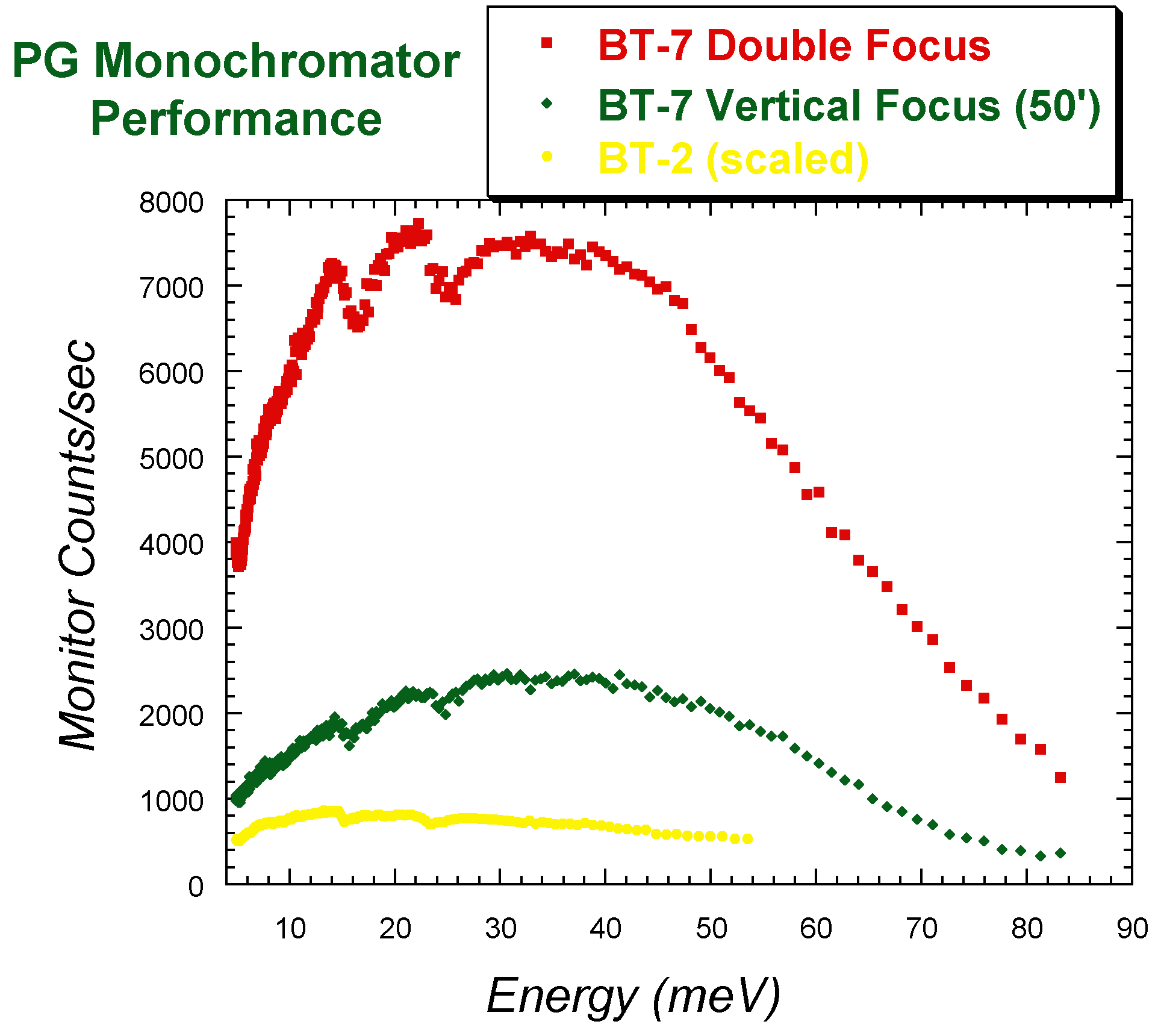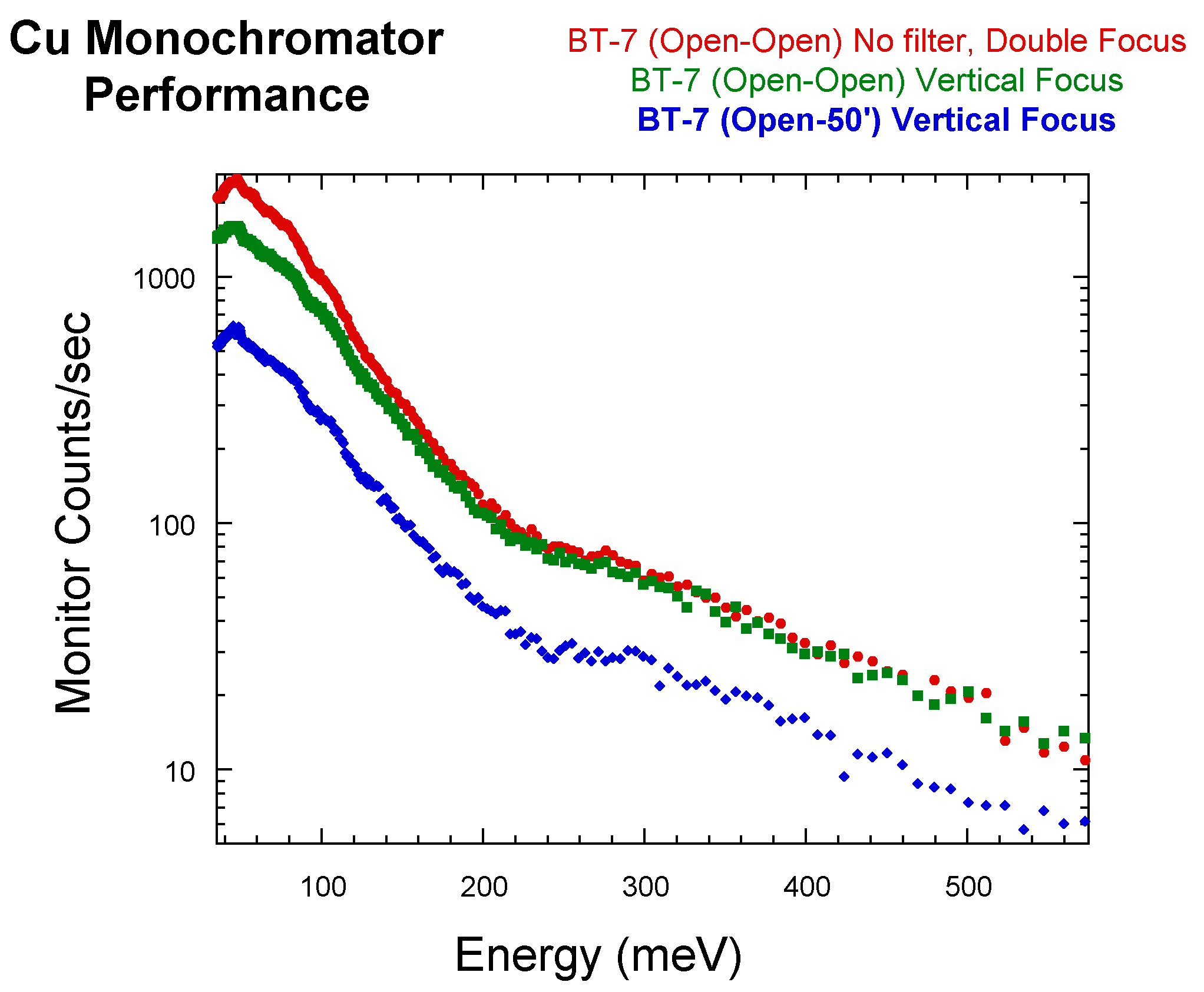BT7 Operational Notes
The instrument features the choice of either a Cu(220) or PG(002) doubly-focusing monochromator, providing a continuous incident neutron energy range from 5 to 500 meV. The 400 cm2 reflecting area for each monochromator yields as much as an order-of-magnitude gain of neutrons onto the sample compared with the old thermal triple-axis spectrometers. The reactor beam and post monochromatic beam elements offer a wide range of choices to optimize the resolution and intensity of the instrument, with available fluxes well into the 108 n/cm2/s range.
The sample stage of the instrument includes two coaxial rotary tables, one for sample rotation and one for the independent rotation of magnetic field coils, and a computer controlled sample goniometer and elevator. He3 cells are available to provide full polarization capability with both monochromators and PG analyzer.
The analyzer system has a multi-strip PG(002) analyzer array consisting of 13 individual blades 2 cm wide and 15 cm tall, that can be used in a horizontally focused mode, or in a flat configuration either with a linear position-sensitive detector or with conventional Söller collimators. The blades are mounted in perfect Si single crystals (rather than the original Al backings) that are extremely fragile, for low background. All options are be under computer control and can be selected and interchanged by the experimenter without requiring any mechanical changes or user intervention inside the analyzer system. PLEASE DO NOT TOUCH ANYTHING INSIDE THE ANALYZER--SOME PARTS ARE EXTREMELY DELICATE AND YOU CAN CAUSE CATASTROPHIC DAMAGE! A separate diffraction detector is provided in front of the analyzer for Bragg peak measurements, and a series of 11 detectors are imbedded in the shielding behind the analyzer to continuously monitor the neutron flux entering the analyzer system. These detectors can also be used for measurements of the instantaneous correlation function, for example, or with a radial collimator to determine a diffraction pattern over a limited angular range. The PSD can also be used with a radial collimator to determine the diffraction pattern or instantaneous correlation function, with higher resolution.
General Specifications for BT-7
- Double focusing PG(002) (d=3.35416 Å) or Cu(220) (d=1.273 Å) monochromator crystals, 20X20 cm2, 30' nominal mosaic FWHM.
- PG filter in reactor beam, remotely insertable.
- Velocity Selector in the reactor beam to suppress higher order neutrons, reduce fast background,and other sources of spurious peaks and background. Detailed VS information here.
- Flat PG or horizontally focused PG (13 blades, 15 cm X2 cm wide each) analyzer system, 30' nominal mosaic FWHM.
- He3 polarizers. Computer controlled vertical or horizontal guide field at sample position. Information about polarized beam operation here.
- Monochromator take-off angles 2θM from 16 to 75 degrees
- Variable incident energy from 5.0 to ≈500 meV (but there are very few neutrons at the very high energies).
- Scattering angles from 0 to 120 degrees
- Söller slit collimation of 10', 25', 50', and Open in the reactor beam. At each position, 10', 25', 50', 80', and Open before and after the sample, and 25', 50', 120', and Open before the detector.
- Radial collimators of 40', and 80' before and 80' after the analyzer.
- Single low-background detector, series of detectors behind the analyzer system, 48 wire position sensitive detector.
The overall dimensions of the instrument are:
Source to Monochromator: 488 cm
Monochromator to Sample: 206 cm
Sample to Analyzer: Variable, from 165 cm to 229 cm
Analyzer (center) to detector: 35 cm
Below information is without the velocity selector. Information with the velocity selector is here.

Wavelength contaminations in the incident beam using the PG monochromator with no filter in the reactor beam (variable incident energy).
Monitor Correction factor for the PG monochromator. This correction factor is available in DAVE as a data reduction choice.This correction factor is to be used only if the velocity slector is NOT employed. When the velocity selector is used, typically there is no need for a correction. However, at the lowest energies a small correction can be applied if needed, and those details are in the velocity selector webpage.

Fluxes
Some neutron fluxes measured at the sample position are given below:
PG(002) monochromator
40 meV, Open'-50' (no filter), 1.0 ×108 n/cm2/s
40 meV, Open'-80' (no filter), 1.4 ×108 n/cm2/s
40 meV, Double Focus, 1.8 ×108 n/cm2/s
14.7 meV, Open'-50' (PG filter) 2.4 ×107n/cm2/s
14.7 meV, Open'-80' (PG filter) 3.4 ×107n/cm2/s
13.7 meV, Double Focus (PG filter), 4.6 × 107n/cm2/s
Cu(220)
100 meV, Open'-50', 2.0 ×107n/cm2/s
50 meV, double focus, 6.1 ×107n/cm2/s
Return to BT-7 Main Page
Contacts
-
(301) 975-6246

